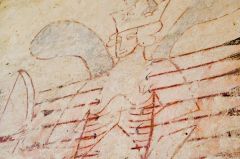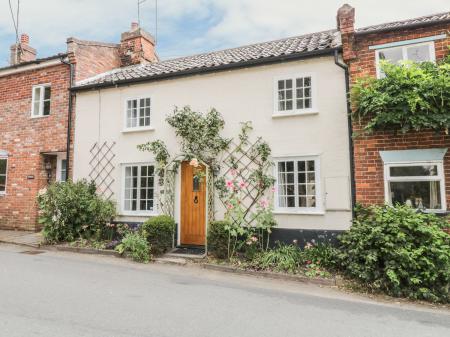St Edmund, King and Martyr

According to legend, Edmund was the son of Alkmund, King of Saxony. When Offa, King of East Anglia, went on a pilgrimage to the Holy Land, he stayed for a time at Alkmund's court. He was much taken with Edmund, and eventually named the boy as his heir and successor. Offa died on his pilgrimage, and Edmund was offered the crown. He came to England at the age of 14 to be crowned King of East Anglia, a ceremony thought to have taken place at Bures, on the Suffolk border with Essex.
Edmund was crowned by Bishop Humbert on Christmas Day, 855 AD, at a site where St Stephen's Chapel now stands. He ruled East Anglia in relative peace until 869, when chaos descended upon the kingdom - chaos in the form of a Danish invasion.
Edmund gathered an army to meet the Danish threat, and met them in combat near Thetford. The Danes won the day and Edmund fled, finding refuge in a wooided area known to the chroncilers as Haeglesdune, presumed to be Hoxne. The king hid under a bridge across the stream known as Goldbrook. However, a couple on their way to get married saw the glint of his spurs under the bridge, and betrayed his wherabouts to the pursuing Danes. According to legend, Edmund cursed them and any couple who might cross the bridge to get married. For centuries brides were reluctant to cross the bridge on their wedding day.
As for Edmund, he was tortured by the Danes, who tried to get him to renounce his Christian faith. When he refused, they tied him to an oak tree on the hill above the stream and shot him with arrows until he died. The Danes then cut off his head and threw it into the woods, believing that his followers would not then be able to give him a proper burial. Edmund's knights searched high and low for the king's head, and finally found it in a thicket, carefully guarded by a wolf (possibly the king's own wolfhound). They buried the king nearby and erected a wooden chapel at the site. Some 33 years later the body was exhumed and reburied at Boedericsworth, which was renamed Bury St Edmunds in the king's honour.
Edmund's rise to sainthood was swift; he was certainly regarded as a saint by the year 900, and a cell of Benedictine monks was established at the site of his martyrdom in Hoxne. Miracles were reported at the saint's shrine, and pilgrims flocked to the site, making the abbey one of the most important (and richest) in England. So popular was Edmund that he was regarded as England's patron saint until Edward III created the Order of the Garter and elevated St George to that post.
The story does not end there, however. A huge old oak was known locally as St Edmund's Oak. In 1848 the oak fell down, and when the trunk was cut up an old arrowhead was found buried within it, about 5 feet from the ground. Tree ring dating suggested that the iron point was lost in the tree about 1000 years previously. Proof of the martyrdom? Hardly, but it does add to the story, and enhance the mystique surrounding Edmund and his death. A stone cross marks the spot where the oak tree stood, beside Cross Street, near Goldbrook.
Edmund gathered an army to meet the Danish threat, and met them in combat near Thetford. The Danes won the day and Edmund fled, finding refuge in a wooided area known to the chroncilers as Haeglesdune, presumed to be Hoxne. The king hid under a bridge across the stream known as Goldbrook. However, a couple on their way to get married saw the glint of his spurs under the bridge, and betrayed his wherabouts to the pursuing Danes. According to legend, Edmund cursed them and any couple who might cross the bridge to get married. For centuries brides were reluctant to cross the bridge on their wedding day.
As for Edmund, he was tortured by the Danes, who tried to get him to renounce his Christian faith. When he refused, they tied him to an oak tree on the hill above the stream and shot him with arrows until he died. The Danes then cut off his head and threw it into the woods, believing that his followers would not then be able to give him a proper burial. Edmund's knights searched high and low for the king's head, and finally found it in a thicket, carefully guarded by a wolf (possibly the king's own wolfhound). They buried the king nearby and erected a wooden chapel at the site. Some 33 years later the body was exhumed and reburied at Boedericsworth, which was renamed Bury St Edmunds in the king's honour.
Edmund's rise to sainthood was swift; he was certainly regarded as a saint by the year 900, and a cell of Benedictine monks was established at the site of his martyrdom in Hoxne. Miracles were reported at the saint's shrine, and pilgrims flocked to the site, making the abbey one of the most important (and richest) in England. So popular was Edmund that he was regarded as England's patron saint until Edward III created the Order of the Garter and elevated St George to that post.
The story does not end there, however. A huge old oak was known locally as St Edmund's Oak. In 1848 the oak fell down, and when the trunk was cut up an old arrowhead was found buried within it, about 5 feet from the ground. Tree ring dating suggested that the iron point was lost in the tree about 1000 years previously. Proof of the martyrdom? Hardly, but it does add to the story, and enhance the mystique surrounding Edmund and his death. A stone cross marks the spot where the oak tree stood, beside Cross Street, near Goldbrook.

